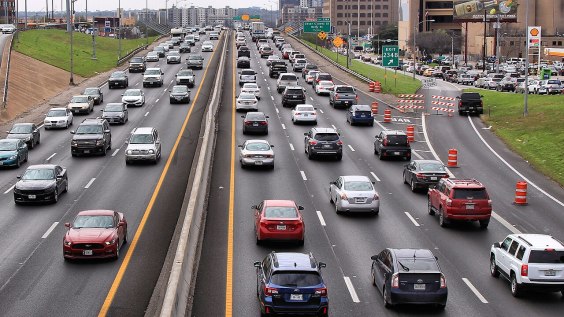During the coronavirus outbreak, Bogotá, Colombia, and Mexico City have temporarily expanded their bike lane network in an effort to reduce crowding on transit. Closer to home, Philadelphia and New York are opening streets for car-free transportation and recreation during the outbreak, making room for residents to practice “social distancing” and avoid exposure to respiratory droplets by maintaining at least 6′ of clearance from each other.
But so far, Chicago has no concrete plans to follow suit. Here’s what Chicago Department of Transportation commissioner Gia Biagi had to say on the subject on Monday:
We’re paying attention to what other cities are doing in every case, and certainly I should add that we’re following the lead of our Chicago Department of Public Health in making all of these decisions. But we’re actually looking at that issue as well, looking at what makes sense for Chicago. You’re right, traffic is really light right now. It’s also cold, so we’re not seeing what we might [normally] see in terms of activity on the street, and everybody hopefully is following the order. But, no, that’s something that we’re looking at very closely to seeing how we can make it as easy as possible for people to move around, particularly on bikes and walking.
But with sunshine and temperatures in the upper fifties today, it’s clear that the city of Chicago can’t drag its feet on this issue any longer. If you’ve been out to the Lakefront Trail or The 606 lately in nice weather during prime hours, you’ve probably seen some unsafe crowding, and people disregarding social distancing rules.

“The Chicago Park District is working on signage to help remind residents to maintain proper social distancing,” spokesperson Michele Lemons said on Monday. “We trust Chicagoans will exercise good judgment and common sense during this time.”
However, this afternoon, Mayor Lori Lightfoot said she’s considering closing all city parks and the entire lakefront if people don’t change their ways by avoiding crowding. The parking lots of many parks and beaches in California have been closed due to crowding. Lightfoot noted that people have been playing team sports, like basketball, and using playground equipment, even though that’s unsafe and against the rules of Illinois’ “Stay at Home” order.

The city is also planning to step up police patrolling of the lakefront, with officers telling large groups of people to disperse. That’s a reasonable strategy, provided that officers avoid singling out youth or people of color for enforcement or harassment, and that the police simply issue warnings, rather than writing tickets, let alone making arrests. But preferably this “lifeguarding” work would be done by park district employees to reduce the potential for police-involved violence and cut costs.
However, these are punitive “stick” approaches, and it’s really not the fault of residents that so much of Chicago’s public space is dedicated to driving and storing cars, and so little is dedicated walking, biking, recreation, and green space. We should also provide a “carrot” to encourage social distancing by opening up many miles of streets for car-free recreation. Major streets and expressways are largely empty nowadays, which makes traffic jams a non-issue, while encouraging dangerous speeding.

So it would make tons of sense to temporarily dedicate streets that parallel major highways to car-free walking, biking, and low-density outdoor activities. Since Lake Shore Drive proper has few cars on it right now, pedestrianize Inner Lake Shore Drive. The same goes for the Dan Ryan Expressway and South State Street; the Stevenson and Archer Avenue; the Ike and Jackson Boulevard; and the Kennedy and Milwaukee Avenue. Drivers could access homes and business via cross streets and alleys, as is done during car-free “Open Streets” events. If necessary low-speed motor vehicle access on the main streets could be permitted for people with mobility challenges, deliveries, and local residents.
Chicago’s hated parking meter contract could complicate matters, since the city is normally required to compensate the parking concessionaire for any lost meter revenue due to street closures. But perhaps the concessionaire could be persuaded to do the right thing by giving the city a pass for the duration of the pandemic.

On a more modest scale, at the very least the city should facilitate and encourage the temporary pedestrianization of side streets for block parties, common during the summer. Usually these require a critical mass of residents to sign a petition agreeing to the event. But perhaps that requirement could be reduced or waived completely if a handful of people on the block ask the city for the street to be opened for walking, biking, and socially-distanced play.
But to maximize the ability of Chicagoans to travel and recreate safely, without being exposed to the virus or dangerous drivers, let’s go bold with a citywide network of car-free major streets. After the “Stay at Home” order is lifted, businesses reopen, and motorized traffic increases again, we can surrender all that public space to big, largely-empty metal boxes once more.
That is, unless residents feel that the car-free streets were so safe, efficient, peaceful, and fun that they refuse to surrender all that room on the road to deadly, polluting, traffic-clogging machines again. In that case we could replace many of the car trips by creating high-speed bus lanes on those corridors. Along with all the additional walking and biking, it would likely become easier than ever for Chicagoans to get where they need to go.
Here are some tips on preventing the spread of the coronavirus, and advice for Chicagoans on what to do if you think you may have been exposed to the virus.





